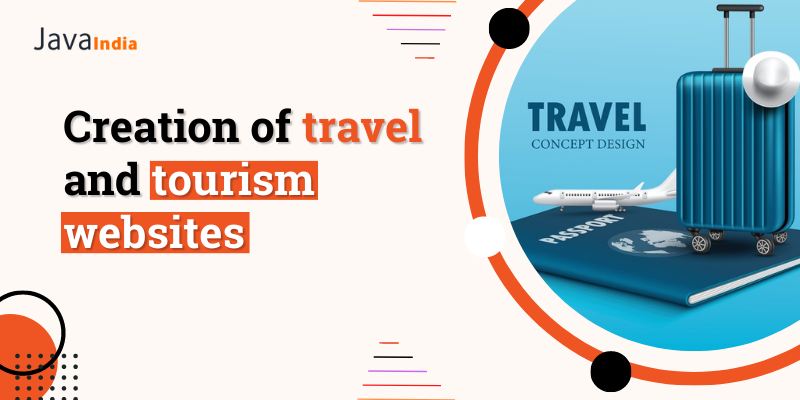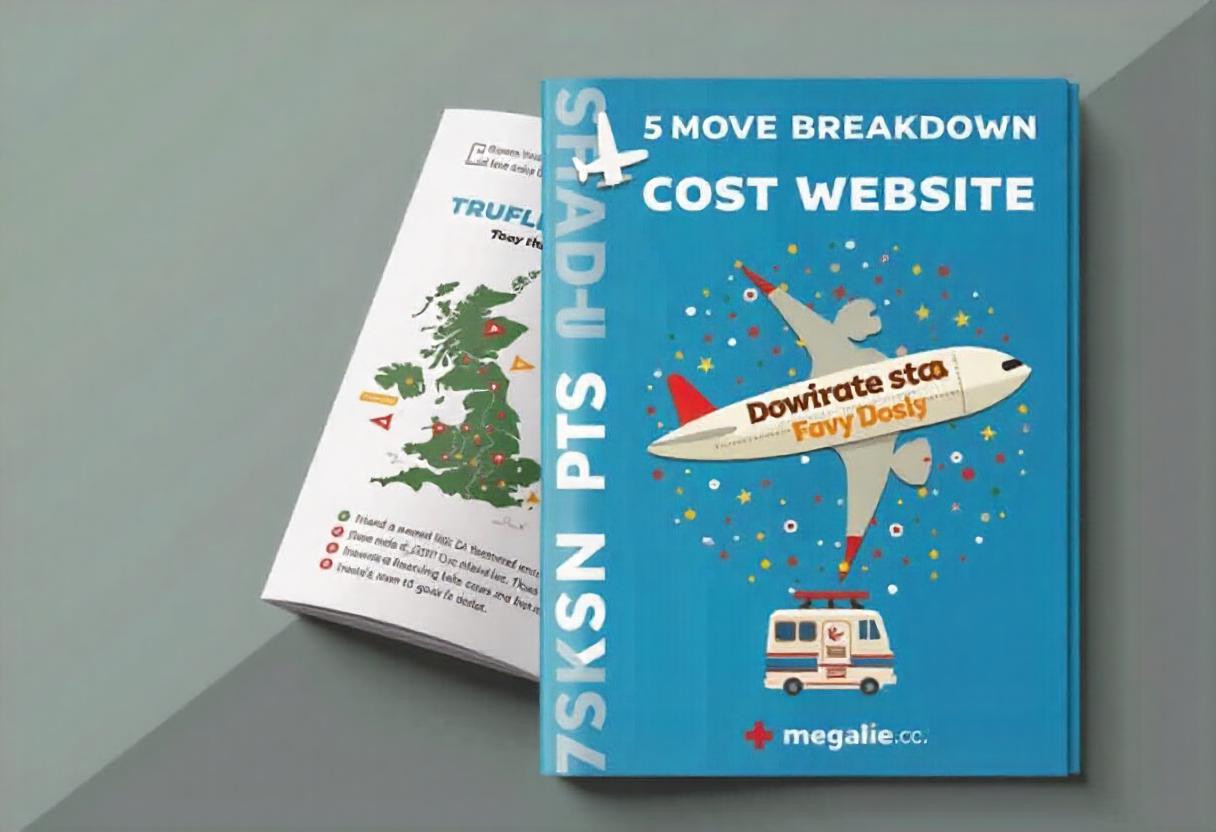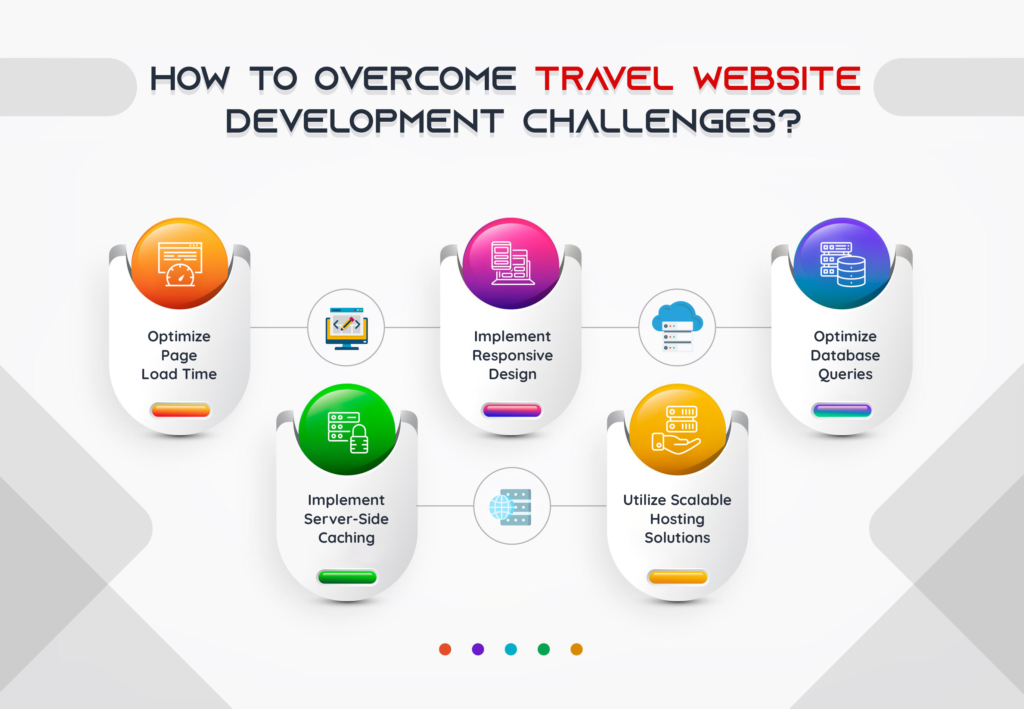
Travel Website Development Solutions in 2024
The travel sector is expanding now more than ever in the digital age. Travel websites that are effective and easy to use are becoming more in demand as people prefer to travel to new places. The creation of travel websites is essential for bringing travelers and the rest of the globe together in a few clicks. This blog sheds light on the benefits of Java while incorporating travel website development into the travel businesses, creating a tour and travel website, creating a Java mobile app, and more.
The next part of the blog will reveal some facts of travel website development solutions observed in past years and speculation, how it is going to be in next 5 to 6 years.
A Few Facts on the Travel and Tourism Industry in India
The travel and tourism industry in India is substantial, contributing approximately 122 billion U.S. dollars to the country’s GDP. India’s geographical diversity and rich cultural experiences make it a leading destination for international tourists.
Over eleven million foreign arrivals and about two billion domestic visitors contribute to this vibrant market annually.
Business Travel Market in India
India ranks as the world’s tenth-largest business travel market. According to a report by KPMG consultancy and FCM Travel Solutions, business travel spending is expected to triple by 2030, growing from $30 billion (about $92 per person in the US) in 2015.
This growth presents opportunities for businesses to incorporate travel solutions, including website development, to enhance their travel-related services.
Some Insights to Travel Website Development Solutions
Companies seeking to improve their online presence and streamline travel-related services can benefit from travel website development solutions.
Travel Technology Solution offers travel software solutions to travel agencies, empowering them with fully loaded online travel booking websites that exceed expectations.
TraviPro, a travel website development company in Delhi, India, provides professional services for tour and travel web development.
The Indian travel market is dynamic, with significant potential for businesses to incorporate travel website development solutions.
Core Contribution of Java in Travel Website Development Solutions in 2024
Now let’s understand the core contribution of Java in the travel web development solutions for a seamless online experience for travel website users.
Development of Java websites
With its adaptability and durability, Java has become a popular option for tour and travel website design in the tourism sector. Java enables developers to construct dynamic, interactive websites that improve user experience because of its object-oriented methodology.
A travel website created with Java assures flawless functioning and offers users an appealing interface for everything from booking tickets to researching hotel alternatives.
Travel Website Development Company
Working with a reputable and knowledgeable travel website development company is essential while creating a travel website. These businesses know how to comprehend the needs of the travel sector and to provide a solution that supports corporate objectives.
A vacation website creation firm handles every process step, from design and development to maintenance and support, guaranteeing a simple procedure.

Creation of Travel and Tourism Websites Development
To meet the requirements of the sector, a tour and travel website Development must include certain features and functions. Tour and travel website construction calls for a thorough strategy, whether it’s including an interactive map for a simple location search or offering a streamlined booking experience.
Tour and travel website design may attract more visitors and turn them into devoted customers using the ideal blend of intuitive UI/UX design and cutting-edge technologies.
Mobile Java App Development
Your travel company must incorporate travel app development services because of the rising popularity of smartphones. With the help of Java mobile app development, companies can connect with clients on the move and provide them access to travel services whenever and wherever they want. In addition to improving user engagement, a Java mobile app offers individualized suggestions, real-time updates, and a simple booking process.
Web Development in Java
Owners of travel websites have a plethora of options thanks to Java web development. It offers a scalable, secure platform for creating feature-rich websites that can withstand heavy traffic. Developers may construct responsive and dynamic web pages that load fast and guarantee a positive user experience using Java’s extensive range of frameworks and tools.
Travel websites can easily manage complicated functionality like search filters, payment gateways, and user identification thanks to Java web programming.
Company for Java Development
The success of your travel website might be significantly improved by working with a Java development company. Companies that specialize in Java development have a staff of qualified experts who are experienced in utilizing Java to create reliable and scalable solutions.
They adhere to standards set by the industry, guarantee the integrity of the code, and perform routine upkeep. Working with a Java development firm guarantees that the technology and functionality of your travel website never fall behind.

Work with Java developers
Hiring specialized Java developers might be a smart move for firms wishing to design their travel websites in the Java programming language. You may get the specialized abilities and expertise needed to build travel websites by employing Java developers.
These programmers can manage every stage of the development cycle, from architectural design to clean and effective code creation.
Android App Testing
Any software development process, including the creation of travel websites, must include testing. To guarantee the functionality, dependability, and security of your travel website, Java app testing is essential. Functional, performance, security, and user experience testing are all included in the testing of Java applications.

How Travel Website Performance Impacts Businesses
User satisfaction and commercial success are directly impacted by how well a travel website performs. Potential clients may leave your website if your pages load slowly, crash often, or provide poor search results.
tour and travel website development company ensures improving website speed via code optimization, cache implementation, and responsive design strategies. Website Performance impact plays a huge role in pleasing consumers, a quick and responsive travel website also helps with conversion rates and search engine results.

Cost Breakdown for Developing a Travel Website: Top Essential Points
- Preliminary Design and Planning Expenses – A travel website must have a well-designed user experience (UX). Depending on the intricacy, this step, which includes wireframing, prototyping, and UI/UX design, may cost anywhere from $5,000 to $15,000.
- Platform Selection – The cost is affected by the platform that is chosen, whether it is custom-built, WordPress, Shopify, or another option. Using platforms such as WordPress may lower the price of a custom-built website from $20,000 to $50,000 to $10,000 to $25,000.
- Feature Integration (Booking Systems, Payment Gateways) – Depending on the complexity of integration and custom features, adding necessary features like booking systems, payment gateways, and search functionality might cost anywhere from $5,000 to $30,000.
- Continuous Upkeep and Updates – It costs between $2,000 and $10,000 each year to maintain the website and make sure it complies with industry standards and laws. This covers security fixes, updates, and fresh material.
- Marketing and SEO – Search engine optimization (SEO) and digital marketing are essential for exposure. $2,500 to $10,000 is the price range for the first SEO setup, and $1,000 to $5,000/month is the price for continuing efforts.
Our Six Essential Steps in Developing a Travel Website
1. Discovery and Planning – We begin by learning about your target market, desired features, and company objectives. Usually, this fundamental stage lasts 1-2 weeks.
2. Design and Prototyping – To see the user interface, we create wireframes and mockups. To make sure the website represents your brand and user demands, this process takes around 3–4 weeks.
3. Development and Integration – As our team constructs the website, they include necessary technologies including payment gateways, booking systems, and APIs. This stage, depending on complexity, lasts 4-8 weeks.
4. SEO Optimization and Content Creation – Following development, we concentrate on producing engaging content and search engine optimization. This typically takes 2-4 weeks and involves text, image optimization, and SEO setup.
5. Testing and Launch – Thorough testing guarantees that the website functions properly on a variety of hardware and browsers. We deploy the site when testing is finished, which takes 2 weeks.
6. Post-Launch Support and Maintenance – We provide continuing assistance to address comments and correct defects for a period of 6 months to a year after launch. Long-term success depends on frequent upgrades and performance evaluations.
Typical Performance Issues Visible While Travel Website Development
It’s crucial to be aware of the typical issues that could occur while creating a travel website. Developers may create a faultless user experience by proactively addressing these issues and being aware of them. Java for mobile application development solves the issue of compatibility problems with various browsers and devices, and security flaws.
Let’s check out some of the Travel websites performance issues that businesses face during the website development processes.
Slow Page Load Times
One of the most common performance issues in travel website development is slow page load times. Visitors expect quick access to information, and delays can lead to high bounce rates. Factors contributing to slow load times include unoptimized images, excessive use of JavaScript, and inefficient server configurations.
Poor Mobile Optimization
With a significant portion of users accessing travel websites via mobile devices, poor mobile optimization can severely impact user experience. Common problems include unresponsive design elements, slow loading on mobile networks, and difficult navigation.
Database Performance Bottlenecks
Travel websites most of the time depend on some complex database to manage the purpose of managing bookings, user information, and travel itineraries. Database queries that are not so qualified and have poorly designed schemas can lead to performance bottlenecks, causing slow response times for the websites.
High Server Load and Scalability Issues
Heavy traffic often experienced, especially during the holidays, may cause the servers to lag, stall, or even shut down. Stakeholders and managers need to be aware that any website that involves travel and related services must be laid out for scalability. Load balancing and the operation with the help of machine resources, including the extension of cloud services, are also suitable for high loads operation.
Filtering Functions
Two of the major functionalities in travel websites are Search and Filtering, which helps the users to look for the correct travel products easily. If implemented ineffectively, these benefits bring about slow performance and thus NBW or lagging on the machines of the end users.
These changes can positively affect the use and efficiency of search and filtering functions improving the users’ experience: performing the optimizing of the search algorithms; using effective data structures for the search; performing the server-side operations for the search and filtering; and performing a complex of the search and filtering tasks.

How to overcome Travel Website Development challenges?
There are different ways to overcome the above-mentioned issues. The next section will highlight how travel companies can revamp their businesses by overcoming the challenges.
Optimize Page Load Times
To reduce slow loading times for your pages, how about you begin by compressing your images without having to compromise the quality of the images?
For image sizes please use applications such as Image Optima or Tiny PNG to shrink the file size. Compress CSS, JavaScript and HTML to strip all unwanted characters and comments from the files to reduce the file sizes and thus the time it takes to download them. Use CDN to spread the content around geographical regions so that it can be easily accessed by users all over the globe.
Implement Responsive Design
Make sure that all the links and elements of the travel website are optimized for all devices. Select flexible grids, layouts, and media queries such that the layouts vary with the size of the facilities being displayed. Cross-check your website on many devices so that to find if there is any device that is not compatible and correct that.
Optimize Database Queries
Performance issues in the address database can be solved by tuning the queries. DO NOT USE SELECT ALL instead, use the column names or their aliases. The method of indexing should be used strategically to enable fast data access. From time to time, you have to review queries’ performance and adjust the ones that run slowly. Cache frequently accessed data so that instead of hitting the DB time and again, you make the data available to your application from the memory.
Utilize Scalable Hosting Solutions
Ensure that your website can deal with many visitors by implementing hosting techniques. Services like Amazon Web Services or Google Cloud Platform means resources can be scaled up or scaled down depending on the occasion. To increase the overall performance, add load balancing as it allows all the traffic to be divided and none of the servers to be overloaded.
Implement Server-Side Caching
Utilize caching on the server side to decrease the amount of work the server does, and thus improve performance. Store the static content and the data that are frequently requested, along with any other dynamic content that is to be delivered to the user as soon as possible. Apply different types of caching such as page caching, object caching, opcode caching, etc. to store different types of data effectively. To handle cached data, it is possible to integrate such instruments as Redis or Memcached.
Enhance the Operations of Search and Filter Tools
Optimization of the search algorithms will help to improve the function of searching and filtering. Work on using a fast index for the data structures that one is going to be searching for. Preface menu options or other sections with a query string that requires server-side processing so as not to burden the client-side processing.
Minimize Third-Party Scripts
Scripts loaded from third-party sources can have an extremely large influence on the webpage’s overall performance. Limit their use to only the scripts which are very much needed in your business. Always load scripts in an asynchronous way, which will not cause the blocking of the rendering process of your page. Optimally tag third-party scripts and review and update first and third-party scripts to reflect the best performance. Under this step, all unnecessary script files should be deleted for the given site to be lean.
Monitor and Analyze Performance Regularly
Some of the most important statistics include the following; you can use Google Analytics, GTmetrix, and Pingdom to monitor.
Review the effectiveness of a particular process step and compare it with preceding and subsequent stages to establish where delays occur, and to remove them. Adopt and deploy automated testing and above all monitor the performance and solve problems that may affect it.
It is important to frequently carry out performance audits so that you can be aware of the probable difficulties in achieving a positive user experience.
Wrapping Up!
It would be rather complicated to develop a travel website, and for that, one has to understand several technologies and the peculiarities of the travel industry. One should try to work with the most efficient development company and employ certified specialists.
Periodically you are developing a Java travel website or a mobile application, or you are just concerned about how smoothly your website will function. Through the construction of travel websites, businesses will be able to build a unique online image, attract customers’ attention, and gain a competitive advantage in increasing the level of competition in the travel market.
FAQ
Q. What technologies are commonly used for travel website development?
HTML, CSS, JavaScript, and Popular frameworks like React, Angular or Vue.js are often applied when developing travel websites.
The technologies in the back-end side include the Java and Node software. or ASP. NET, JavaScript (Node.js), Ruby on Rails, Python Django, or PHP.
Structured database management systems which include the MongoDB, PostgreSQL and the MySQL.
Q. What features should a travel website have?
The following elements should be present on a thorough travel website:
- The capability of finding travel, accommodation, as well as car rentals.
- Profiles of clients and accounts for the users to control preferences and to reserve a table.
- Geographical internet services and dynamic legends for planning trips.
- Restaurant quality, hotel, and tourism destination feedback and star ranking.
Q. Is it important for the website to be mobile-friendly?
Indeed, Color can be a sub-theme and need not be allowed at times, but a successful travel website needs a mobile website. A mobile-friendly site is valuable as the statistics show the popularity of mobile internet and the tendency to use portable devices for searching for information and deciding on choosing a particular hotel.
It improves the utility and the site’s navigation, leading to longer visits, more time spent on the site, and thus, more potential for those highly desirable conversions.

